 Gallery
4
Gallery
4
The Making of a Scroll
All images copyright 2003. All artwork remains the property of individual artists, and may not be reproduced in part or in full in any medium without written permission from the artists.
![]()
Patent
of Arms (Knight) for Sir Inigo Missaglia by Mistress Rohesia le
Sarjent
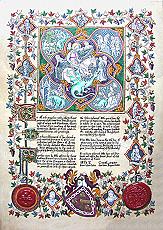
|
This page shows the main stages in execution of a large scroll (60cm x 24, approximately A2) on goat parchment, with gilding on plaster-based gesso. Before any of the actual work begins on the scroll itself, there are many hours of research involved. The time-period for the scroll must be decided, and exemplars of the style studied. This scroll is based on the Bible Historiale, from around 1357, and is in the style known as "International Gothic." The design itself must then be worked out--not only the elements to include, but the overall layout. The design here is of St George slaying the dragon--a fitting knightly quest. The small miniatures represent the knighly virtues: measure, justice, courage, humility, loyalty, courtesy and magnanimity. The calligraphy must be written out (sometimes several times) until the scribe is sure it fits the space allotted (or the design adjusted until it fits the calligraphy, as appropriate). A full-size line drawing will be made on paper, any final adjustments and corrections made, and this design then transferred to the parchment itself. Parchment can be a tricky medium to work with; it is very sensitive to relative humidity and tends to buckle in unexpected places. It may need flattening several times under weights while it is being worked on, unless it is fastened firmly to a board. Care must be taken not to over-wet it, as this can raise a nap which is difficult to flatten out again. Finally, there are the ink and paints themselves. The scroll was written with Chinese ink and illuminated with gold leaf, gold powder and period pigments. Red tones are made from brazilwood and dragon's blood, flesh tones are red ochre and zinc oxide with some egg shell. Blues are lapis lazuli, some with a little black nightshade juice. Greens are Malachite or veridigris, and some parsley juice. Yellow is made from saffron, white from zinc oxide. These paints must prepared by hand, grinding them finely and binding them with gum arabic or glair. |
Initial drawing and gesso
laid for gilding At this stage the design has
been pencilled onto the parchment, and the plaster-based
gesso on which the gold will be laid has been painted on in
several layers and smoothed. The gesso is coloured
pink with red ochre and naturally pink egg shell to give a
warmer base for the gold. Large
image (82
Kb) Gilding and text
completed The scroll text has now been
written, and the gold laid and burnished to a mirror shine.
Rehydrating the gesso sufficiently for the gold to
adhere properly can be quite tricky; success is
dependent on relative humidity. Gum arabic, tinted
with a little saffron, was painted onto the gesso as the
gold was laid. The work must be done in a very still
environment as gold leaf is very delicate and can be blown
around by the slightest draft. Large
image (135
Kb) Red and blue blocked
in The main areas of red and blue
paint have now been filled in and the base colours for the
grisailles--pale grey, flesh tone and pale green--have also
been laid. At this stage the paint is quite flat,
with no details or highlighting. Large
image (187
Kb) Green and yellow blocked
in The green and yellow shades
have now been painted in, similarly to the reds and blues
above. Large
image (193
Kb) First grisailles
completed Details of the grisaille images
are starting to be painted. Grisaille is
a technique of painting in monotone, or with very few
highlights in other colours as in this case, which demands
great skill from the artist. Extra shading has also
been added to the coloured backgrounds, and the device is
essentially finished. Large
image (190
Kb) Finished
Scroll The scroll is now
finished. Diapering has been added to the backgrounds
of all the miniatures, and to the mantling and arms.
Tiny shadow angels and demons have been drawn in to the
background of the main panel. The ivy leaves have been
shaded, and white highlights and dark outlining added to the
all miniatures. The entire design has also been
outlined in black ink with a tiny brush. The end result is simply
spectacular. Large
image (438
Kb)
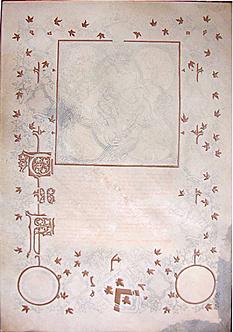
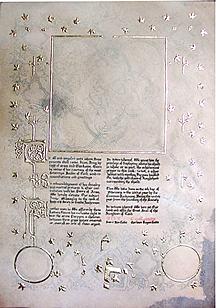
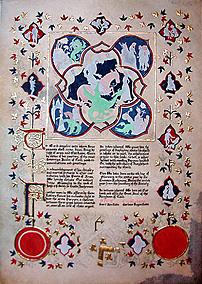
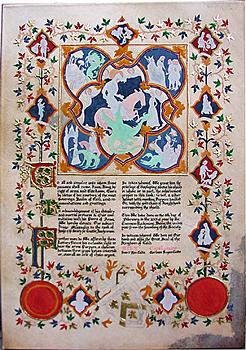
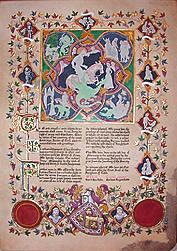

![]()
Home | Guildhall | Gallery 1 | Gallery 2 | Gallery 3 | Library | Model Book | Vault | Almoner | Owlery
![]()